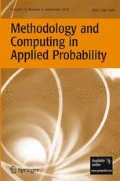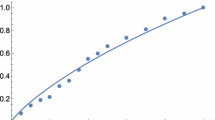Abstract
In this paper, we are interested in the dependence between lifetimes based on a joint survival model. This model is built using the bivariate Sarmanov distribution with Phase-Type marginal distributions. Capitalizing on these two classes of distributions’ mathematical properties, we drive some useful closed-form expressions of distributions and quantities of interest in the context of multiple-life insurance contracts. The dependence structure that we consider in this paper is based on a general form of kernel function for the Bivariate Sarmanov distribution. The introduction of this new kernel function allows us to improve the attainable correlation range.

Similar content being viewed by others
References
Abdallah A, Boucher J-P, Cossette H (2016a) Sarmanov family of multivariate distributions for bivariate dynamic claim counts model. Insur Math Econ 68:120–133
Abdallah A, Boucher J-P, Cossette H, Trufin J (2016b) Sarmanov family of bivariate distributions for multivariate loss reserving analysis. North Amer Actuarial J 20(2):184–200
Artzner P, Delbaen F, Eber J-M, Heath D (1999) Coherent measures of risk. Math Financ 9(3):203–228
Asmussen S, Laub PJ, Yang H (2019) Phase-type models in life insurance: Fitting and valuation of equity-linked benefits. Risks 7(1)
Bladt M, Nielsen BF (2017) Matrix-exponential distributions in applied probability. Matrix-exponential Distributions in Applied Probability. Springer
Bolancé C, Vernic R (2019) Multivariate count data generalized linear models: Three approaches based on the sarmanov distribution. Insur Math Econ 85:89–103
Bowers NL, Gerber HU, Hickman JC, Jones DA, Nesbitt CJ (1997) Actuarial mathematics. Society of Actuaries
Dickson DCM, Hardy MR, Waters HR (2019) Actuarial mathematics for life contingent risks. International Series on Actuarial Science. Cambridge University Press
Dufresne F, Hashorva E, Ratovomirija G, Toukourou Y (2018) On age difference in joint lifetime modelling with life insurance annuity applications. Ann Actuarial Sci 12(2)
Frees EJW, Carriere JF, Valdez E (1996) Annuity valuation with dependent mortality. J Risk Insur 63(2)
Gobbi F, Kolev N, Mulinacci S (2019) Joint life insurance pricing using extended marshall-olkin models. ASTIN Bullet 49(2):409–432
Govorun M, Latouche G (2014) Modeling the effect of health: phase-type approach. Eur Actuarial J 4(1):197–218
Govorun M, Latouche G, Loisel S (2015) Phase-type aging modeling for health dependent costs. Insur Math Econ 62(2015):173–183
Hashorva E, Ratovomirija G (2015) On sarmanov mixed erlang risks in insurance applications. ASTIN Bullet 45(1):175–205
Horn RA, Johnson CR (1991) Matrix equations and the kronecker product. In: Topics in Matrix Analysis. Cambridge University Press
Kim JHT, Bae T, Kim S (2017) Application of the phase-type mortality law to life contingencies and risk management. Appl Stoch Model Bus Ind 33 (2):184–212
Lee M-LT (1996) Properties and applications of the sarmanov family of bivariate distributions. Commun Stat - Theory Methods 25(6):1207–1222
Luciano E, Spreeuw J, Vigna E (2008) Modelling stochastic mortality for dependent lives. Insur Math Econ 43(2):234–244
NEUTS MF (1975) Probability distributions of phase type. Liber Amicorum Prof. Emeritus H. Florin
Neuts MF (1994) Matrix-geometric Solutions in Stochastic Models: An Algorithmic Approach. Courier Corporation. Google-Books-ID: WPol7RVptz0C
Pitacco E, Denuit M, Haberman S, Olivieri A (2009) Modelling Longevity Dynamics for Pensions and Annuity Business. OUP Catalogue. Oxford University Press
Ratovomirija G, Tamraz M, Vernic R (2017) On some multivariate sarmanov mixed erlang reinsurance risks: Aggregation and capital allocation. Insur Math Econ 74:197–209
Sarmanov OV (1966) Generalized normal correlation and two-dimensional fréchet classes. Doclady Soviet Math 168(1):32–35
Shubina M, Lee M-L T (2004) On maximum attainable correlation and other measures of dependence for the sarmanov family of bivariate distributions. Commun Stat - Theory Methods 33(5):1031–1052
Sheldon X, Lin PhD ASA, Liu X (2007) Markov Aging Process and Phase-Type Law of Mortality. North Amer Actuarial J 11(4):92–109
Vernic R (2017) Capital allocation for sarmanov’s class of distributions. Methodol Comput Appl Probab 19(1)
Vernic R (2018) On the evaluation of some multivariate compound distributions with sarmanov’s counting distribution. Insur Math Econ 79:184–193
Yang Y, Hashorva E (2013) Extremes and products of multivariate ac-product risks. Insur Math Econ 52(2):312–319
Zadeh AH, Jones BL, Stanford DA (2014) The use of phase-type models for disability insurance calculations. Scand Actuar J 2014(8):714–728
Author information
Authors and Affiliations
Corresponding author
Additional information
Publisher’s Note
Springer Nature remains neutral with regard to jurisdictional claims in published maps and institutional affiliations.
Appendix
Appendix
1.1 Substochastic Matrix
Definition 5.1
A substochastic matrix is a square matrix with nonnegative entries so that every row adds up to at most 1
1.2 Matrix Exponential
Definition 5.2
Let A be a square matrix of order n, then we call matrix exponential, denoted by eA, the matrix
with \(e^{0_{n}} = I_{n}\), where 0n is the zero matrix of order n.
It is well known that f(x) = ex is the only function to have the property that f(x + y) = f(x)f(y), i.e. exey = ex+y, where \(x,y \in \mathbb {R}\). However, this is not true for matrix exponential.
Proposition 5.1
Let A and B be square matrices of order n. Then,
if ABB = BA.
The derivative of matrix exponential function is given in the following proposition.
Proposition 5.1
The derivative of a matrix exponential function is given by
1.3 Kronecker Product and Kronecker Sum
The Kronecker product and the Kronecker sum are defined as follows
Definition 5.3
Let A = (aij) and B be (n × m) and (l × k) real matrices, respectively. Then the Kronecker product \(A \otimes B \in \mathbb {R}^{nl*mk}\) is the partitioned matrix
Definition 5.4
Let A and B be square matrices of orders n and m respectively. Then the Kronecker sumA ⊕ B is a square matrix of order nm and is given by
Definition 5.5
Consider a matrix A. For k ≥ 1, the k th Kronecker power, \(A^{\otimes _{k+1}}\), and the k th Kronecker sum, \(A^{\oplus _{k+1}}\), are defined inductively by
-
\(A^{\otimes _{1}}=A\) and \(A^{\otimes _{k}}= A\otimes A^{\otimes _{(k-1)}}\) for \(k=2,3,\dots \).
-
\(A^{\oplus _{1}}=A\) and \(A^{\oplus _{k}}= A\oplus A^{\oplus _{(k-1)}}\) for \(k=2,3,\dots \).
1.4 Some Properties of Kronecker Product and Kronecker Sum
Proposition 5.3
Define Let Ml,j denote the space of i × j real (or complex) matrices. Let A ∈ Mm,n, B ∈ Mp,q, C ∈ Mn,k, and D ∈ Mq,r. Then
Proposition 5.4
Define Let Ml the space of square real (or complex) matrices. Consider two matrices A ∈ Mp and B ∈ Mq
- (i):
-
Assume that μ is an eigenvalue for A with corresponding eigenvector x, and ξ is an eigenvalue for B with corresponding eigenvector y. Then μ + ξ is an eigenvalue of A ⊕ B with corresponding eigenvector y ⊗ x.
- (ii):
-
Any eigenvalue of A ⊕ B arises as such a sum of eigenvalues of A and B
We refer the readers to Horn and Johnson (1991) for more details on Matrix Mathematics and proofs of the previous propositions.
Rights and permissions
About this article
Cite this article
Moutanabbir, K., Abdelrahman, H. Bivariate Sarmanov Phase-Type Distributions for Joint Lifetimes Modeling. Methodol Comput Appl Probab 24, 1093–1118 (2022). https://doi.org/10.1007/s11009-021-09875-5
Received:
Revised:
Accepted:
Published:
Issue Date:
DOI: https://doi.org/10.1007/s11009-021-09875-5



